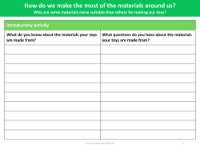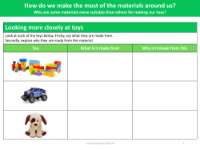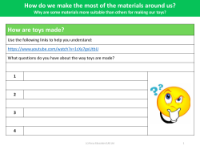Why are some materials more suitable than others for making our toys? - Presentation

Science Resource Description
The national curriculum for Science Year 2 sets out educational goals for pupils to understand the uses and properties of different materials and why some are more suitable than others for certain tasks. For instance, children learn that metal can be versatile, used for making coins, cans, cars, and table legs, while wood can be found in matches, floors, and telegraph poles. The curriculum encourages pupils to think about the properties that make materials such as glass, wood, plastic, brick, and paper suitable for specific jobs. It also highlights the importance of creative thinking in material usage and introduces students to historical figures like John Dunlop and Charles Macintosh, who developed innovative materials that are still in use today.
During the course of the unit, students explore how materials can be manipulated by squashing, bending, twisting, and stretching, and why certain materials are chosen for particular functions. They engage in practical activities such as fair testing to compare the waterproof nature of different materials and grouping exercises based on material properties. The curriculum is designed to build on the knowledge gained in Year 1 and prepares pupils for more advanced concepts in Year 4. Vocabulary terms like 'stretching', 'squashing', 'bending', and 'twisting' are introduced to help children articulate their understanding of material properties. The learning process is structured to ensure that pupils can link new information to prior knowledge, learn and apply new concepts, check their understanding, and retain key information for long-term recall.






